Solar eclipse of July 24, 2055
| Solar eclipse of July 24, 2055 | |
|---|---|
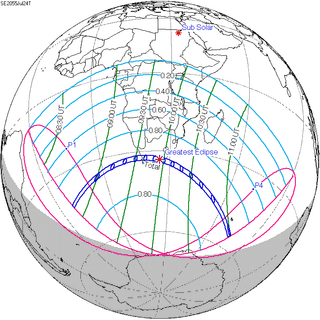 Map | |
| Type of eclipse | |
| Nature | Total |
| Gamma | -0.8012 |
| Magnitude | 1.0359 |
| Maximum eclipse | |
| Duration | 197 sec (3 m 17 s) |
| Coordinates | 33°18′S 25°48′E / 33.3°S 25.8°E |
| Max. width of band | 202 km (126 mi) |
| Times (UTC) | |
| Greatest eclipse | 9:57:50 |
| References | |
| Saros | 127 (60 of 82) |
| Catalog # (SE5000) | 9631 |
A total solar eclipse will occur on July 24, 2055. A solar eclipse occurs when the Moon passes between Earth and the Sun, thereby totally or partly obscuring the image of the Sun for a viewer on Earth. A total solar eclipse occurs when the Moon's apparent diameter is larger than the Sun's, blocking all direct sunlight, turning day into darkness. Totality occurs in a narrow path across Earth's surface, with the partial solar eclipse visible over a surrounding region thousands of kilometres wide.
Related eclipses
Solar eclipses 2054-2058
Each member in a semester series of solar eclipses repeats approximately every 177 days and 4 hours (a semester) at alternating nodes of the Moon's orbit.
| 117 | August 3, 2054 Partial |
122 | January 27, 2055 Partial |
| 127 | July 24, 2055 Total |
132 | January 16, 2056 Annular |
| 137 | July 12, 2056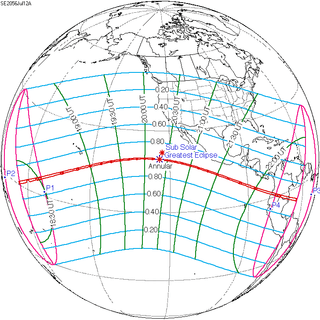 Annular |
142 | January 5, 2057 Total |
| 147 | July 1, 2057 Annular |
152 | December 26, 2057 Total |
| 157 | June 21, 2058 Partial |
Saros 127
It is a part of Saros cycle 127, repeating every 18 years, 11 days, containing 82 events. The series started with partial solar eclipse on October 10, 991 AD. It contains total eclipses from May 14, 1352 through August 15, 2091. The series ends at member 82 as a partial eclipse on March 21, 2452. The longest duration of totality was 5 minutes, 40 seconds on August 30, 1532.[1]
| Series members 52–62 occur between 1901 and 2100 | ||
|---|---|---|
| 52 | 53 | 54 |
 April 28, 1911 |
 May 9, 1929 |
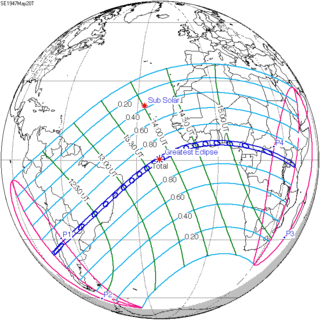 May 20, 1947 |
| 55 | 56 | 57 |
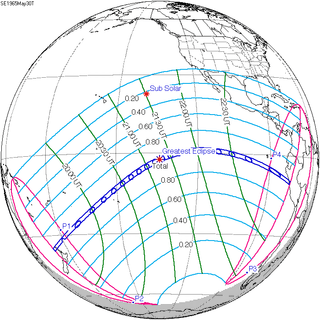 May 30, 1965 |
 June 11, 1983 |
 June 21, 2001 |
| 58 | 59 | 60 |
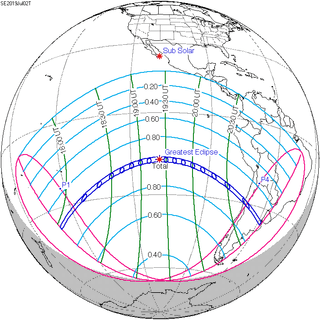 July 2, 2019 |
 July 13, 2037 |
 July 24, 2055 |
| 61 | 62 | |
 August 3, 2073 |
 August 15, 2091 | |
References
External links
| Wikimedia Commons has media related to Solar eclipse of 2055 July 25. |
